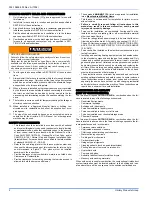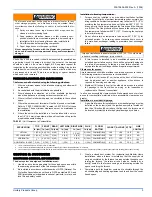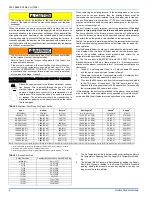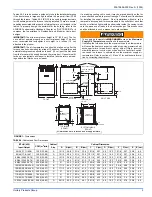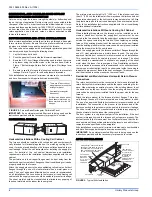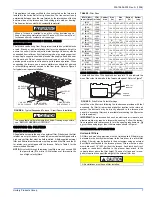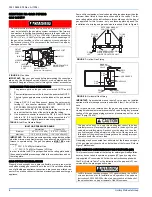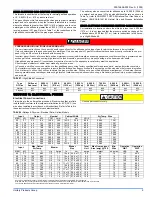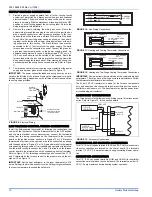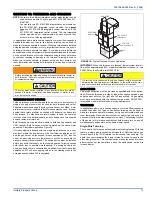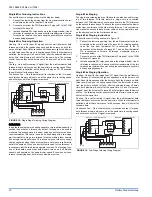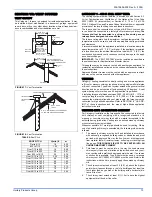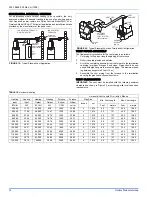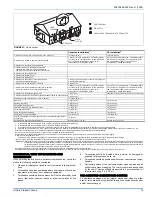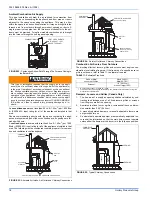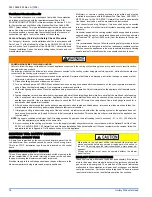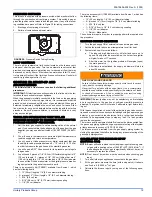
035-19656-003 Rev. A (1004)
4
Unitary Products Group
When the furnace is used in conjunction with a cooling coil, the coil
must be installed parallel with, or in the supply air side of the furnace to
avoid condensation in the primary heat exchanger. When a parallel flow
arrangement is used, dampers or other means used to control airflow
must be adequate to prevent chilled air from entering the furnace. If
manually operated, the damper must be equipped with means to pre-
vent the furnace or the air conditioner from operating unless the damper
is in full heat or cool position.
DUCTWORK INSTALLATION AND SUPPLY PLENUM
CONNECTION
Attach the supply plenum to the furnace outlet duct connec-
tion flanges. This is typically through the use of S cleat
material when a metal plenum is used. The use of an
approved flexible duct connector is recommended on all
installations. This connection should be sealed to prevent
air leakage. The sheet metal should be crosshatched to
eliminate any popping of the sheet metal when the indoor
fan is energized.
When replacing an existing furnace, if the existing plenum is not the
same size as the new furnace then the existing plenum must be
removed and a new plenum installed that is the proper size for the new
furnace. If the plenum is shorter than 12” (30.5 cm) the turbulent air flow
may cause the limit controls not to operate as designed, or the limit con-
trols may not operate at all.
The duct system is a very important part of the installation.
If the duct
system is improperly sized the furnace will not operate properly.
The ducts attached to the furnace plenum, should be of sufficient size
so that the furnace operates at the specified external static pressure
and within the air temperature rise specified on the nameplate.
Table 2 is a guide for determining whether the rectangular duct system
that the furnace is being connected to be of sufficient size for proper fur-
nace operation.
Use the Example below to help you in calculating the duct area to deter-
mine whether the ducts have sufficient area so that the furnace oper-
ates at the specified external static pressure and within the air
temperature rise specified on the nameplate.
Ex. The furnace input is 80,000 BTUH and 1,200 CFM. The recom-
mended duct area is 280 sq.in, there are two 8 x 14 rectangular ducts
attached to the plenum and there are two 7 inch round ducts attached to
the furnace.
1.
Take 8 x 14, which equals 112 sq.in. X 2, which equals 224 square
inch then go to round duct size located in Table 3.
2.
The square inch area for 7 inch round pipe is 38.4, multiply by 2 for
two round ducts which equals 76.8 square inch,
3.
Then take the 224 square inch from the rectangular duct and add it
to the 76.8 sq.in. of round duct. The total square inch of duct
attached to the furnace plenum is 300.8 square inch. This exceeds
the recommended 280 square inch of duct.
In this example, the duct system attached to the plenum has a sufficient
area so that the furnace operates at the specified external static pres-
sure and within the air temperature rise specified on the nameplate.
1.
The Air Temperature Rise is determined by subtracting the Return
Air Temperature Reading from the Supply Air Temperature Read-
ing.
2.
The External Static Pressure is determined by adding the Supply
Duct Static Pressure reading to the Return Duct Static Pressure
reading, adding the pressure across any applied a-coil and the
drop across the return air filter.
The cooling coil must be installed in the supply air duct, down-
stream of the furnace. Cooled air may not be passed over the heat
exchanger.
The duct system must be properly sized to obtain the correct airflow
for the furnace size that is being installed.
Refer to Table 8 and the furnace rating plate for the correct rise
range and static pressures
If the ducts are undersized, the result will be high duct static pres-
sures and/or high temperature rises which can result in a heat
exchanger OVERHEATING CONDITION. This condition can result
in premature heat exchanger failure, which can result in personal
injury, property damage, or death.
TABLE 2:
Minimum Duct Sizing For Proper Airflow
Input
Airflow
Return
1
Rectangular
2
Round
2
Supply
3
BTU/H(kW)
CFM(m³)
In² (cm²)
in. x in.(cm x cm)
in. (cm) dia.
In²(cm²)
40,000(11.72)
1,200(33.98)
280 (711)
14 x 20 (35.6 x 50.8)
18 (45.7)
216 (549)
60,000 (17.58)
1,200 (33.98)
280 (711)
14 x 20 (35.6 x 50.8)
18 (45.7)
216 (549)
80,000 (23.44)
1,200 (33.98)
280 (711)
14 x 20 (35.6 x 50.8)
18 (45.7)
216 (549)
80,000 (23.44)
1,600 (45.31)
360 (914)
18 x 20 (45.7 x 50.8)
22 (55.8)
280 (711)
80,000 (23.44)
2,000 (56.63)
440 (1,118)
20 x 22 (50.8 x 55.8)
24 (60.9)
390 (991)
100,000 (29.31)
1,200 (33.98)
320 (813)
16 x 20 (40.6 x 50.8)
20 (50.8)
336 (853)
100,000 (29.31)
1,600 (45.31)
360 (914)
18 x 20 (45.7 x 50.8)
22 (55.8))
280 (711)
100,000 (29.31)
2,000 (56.63)
440 (1,118)
20 x 22 (50.8 x 55.8)
24 (60.9)
390 (991)
115,000 (35.17)
1,600 (45.31)
360 (914)
18 x 20 (45.7 x 50.8)
22 (55.8))
280 (711)
115,000 (35.17)
2,000 (56.63)
440 (1,118)
20 x 22 (50.8 x 55.8)
24 (60.9)
390 (991)
130,000 (41.03)
2,000 (56.63)
440 (1,118)
20 x 22 (50.8 x 55.8)
24 (60.9)
390 (991)
NOTE: This chart does not replace proper duct sizing calculations or take into account static pressure drop for run length and fittings. Watch out for the temperature rise and static pressures.
1.
Maximum return air velocity in rigid duct @ 700 feet per minute (19.82 m
3
/ minute).
2.
Example return main trunk duct minimum dimensions.
3.
Maximum supply air velocity in rigid duct @ 900 feet per minute (25.49 m
3
/ minute).
TABLE 3:
Round Duct Size
Round Duct Size
Calculated Area For Each Round Duct Size
inches (cm)
Sq.in (cm
2
)
5 (13)
19.6 (126)
6 (15)
28.2 (182)
7 (18)
38.4 (248)
8 (20)
50.2 (324)
9 (23)
63.6 (410)
10 (25)
78.5 (506)
11 (28)
95 (613)
12 (30)
113.1 (730)
13 (33)
132.7 (856)
14 (36)
153.9 (993)


